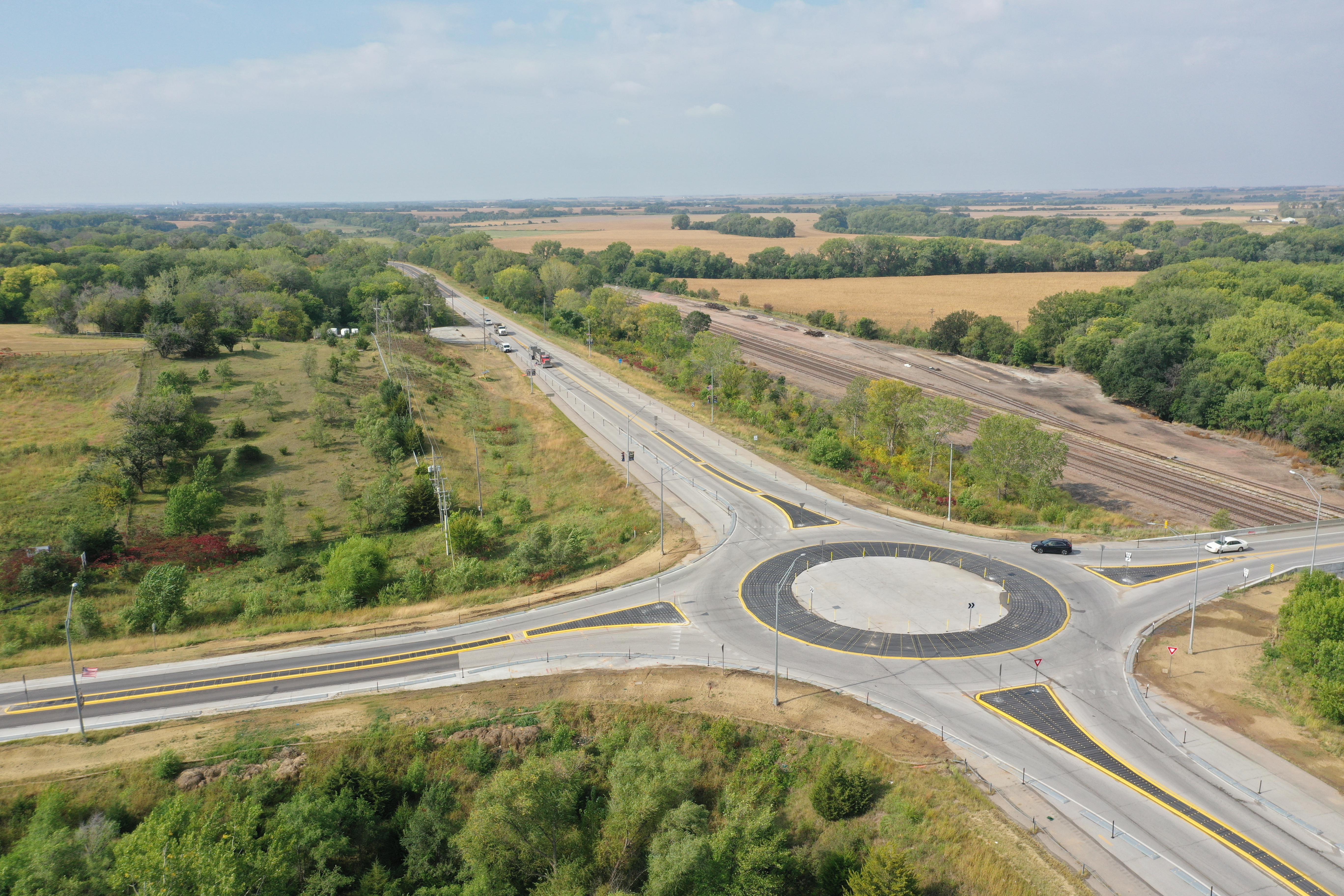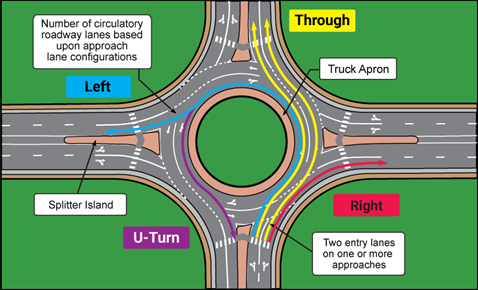A roundabout is an unsignalized, circular intersection where traffic flows at a low speed counterclockwise around a center island. They are designed to maximize safety and minimize traffic delay. Roundabouts have gained in popularity and support throughout the United States as drivers became accustomed to their use and realized the increased safety they provide. They are also used to control speeds in residential neighborhoods and are one of the safest types of intersection design. NDOT is using roundabout intersections more often as a means of managing traffic, reducing vehicle conflicts, increasing intersection capacity, controlling vehicle speeds, and reducing crashes.
How does it work?
At a roundabout intersection, an approaching motorist waits for a safe gap in traffic before entering. This yield at-entry rule keeps traffic from locking up and allows free flow of traffic. When approaching a roundabout there will be a YIELD sign and dashed yield line. Drivers must slow down, watch for pedestrians and bicyclists, and be prepared to stop if necessary. Before entering, drivers yield to circulating traffic on the left but do not need to stop if it is clear.
A conventional roundabout will have arrows mounted in the center island to guide traffic to the right of the center island. Prior to exiting the roundabout, drivers should use their right turn signals and watch for pedestrians and bicyclists while exiting. Left turns and U-turns are completed by traveling around the center island.
Why does it work?
A conventional four-leg intersection has 32 possible vehicle-vehicle conflict points resulting in an elevated risk of severe head-on crashes and right-angle (T-bone) crashes. Roundabouts reduce conflict points to just eight potential vehicle-vehicle conflict points and have a lower risk for severe crashes, due to the angled entry of vehicles and lower speeds. Roundabouts have been successfully implemented in Nebraska and all over the United States and are generally recommended for intersections that would otherwise require traffic signals or stop signs.
Benefits
Safety: Roundabouts significantly reduce the potential for severe crashes because vehicles do not need to make left turns across opposing traffic. If vehicles are involved in a crash at a roundabout, it is generally less severe than those at a conventional intersection. Additionally, roundabouts involve slower speeds, making it safer for both pedestrians and vehicles to move through.
Efficiency: Roundabouts allow for traffic to continuously flow through the intersection, rather than queuing at a traffic signal. Reduced delays also contribute to a decrease in fuel consumption and air pollution.
Increased Capacity: Intersections with a high volume of left turns may be better handled by a roundabout than a multi-phased traffic signal.
Low Operation and Maintenance Costs: Ongoing costs to maintain a roundabout are generally low compared to traffic signals.
Aesthetics: Roundabouts provide greater opportunity to beautify the intersection with additional landscaping and lighting elements.
Trade-Offs
High Impact: Roundabouts may have a larger design footprint than other types of intersection improvements, which can impact nearby homes and businesses.
Driver Familiarity: Although roundabouts are gaining popularity through Nebraska and the United States, some drivers may not be familiar with roundabouts or how they operate.

Different Designs, Same Goal
Nebraska has many roundabouts, including a modular roundabout in Ashland that won the “Best Use of Technology and Innovation, Small Project” award in AASHTO’s 2024 America’s Transportation Awards. Installed in pieces over the existing pavement, this modular design cost about 60% less than a traditional concrete roundabout.
Modular vs. Traditional:
-
Modular: Pre-fabricated pieces assembled on-site; faster and cheaper to construct; flexible for space-limited areas.
-
Traditional: Built entirely on-site from concrete or asphalt; more durable but higher cost and longer construction time.
Roundabout Types in Nebraska:
-
Single-Lane: One circulating lane, ideal for low-to-moderate traffic.
-
Multi-Lane: Two or more lanes for higher traffic volumes.
Driving a Roundabout
The videos and images below provide an illustrated guide on navigating a roundabout safely and properly.
Modern roundabouts are designed to accommodate tractor-trailer vehicles through the use of truck aprons. A truck apron is a raised section of pavement around the center island with a mountable curb, which allows for the back wheels of larger vehicles to travel over.
